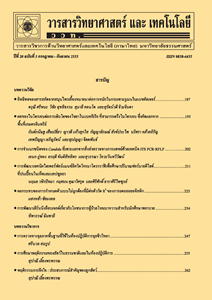อุปกรณ์สร้างภาพแสดงลักษณะพื้นผิวแบบสามมิติและตรวจวัดความหยาบของพื้นผิวโดยเทคนิคเชิงแสงและโครงข่ายประสาทเทียม
Main Article Content
Abstract
บทคัดย่อ
บทความนี้นำเสนออุปกรณ์สร้างภาพแสดงลักษณะพื้นผิวแบบสามมิติและตรวจวัดความหยาบของพื้นผิวโดยเทคนิคเชิงแสงและโครงข่ายประสาทเทียม โดยอุปกรณ์ที่นำเสนอนี้ประกอบด้วย 2 ส่วนหลัก ๆ คือ ส่วนชุดอุปกรณ์ตรวจวัดและส่วนชุดประมวลผลสัญญาณ ซึ่งชุดอุปกรณ์ตรวจวัดจะทำหน้าที่ตรวจวัดความเข้มแสงที่กระเจิงออกมาจากผิววัสดุในแต่ละจุด หลังจากนั้นสัญญาณของค่าความเข้มแสงในแต่ละจุดจะถูกส่งต่อไปยังชุดประมวลผลสัญญาณเพื่อคำนวณหาค่าความสูงของแต่ละจุดโดยใช้โครงข่ายประสาทเทียม ซึ่งความสูงของผิววัสดุในแต่ละจุดนั้นจะถูกนำไปคำนวณเพื่อหาค่าความหยาบของผิววัสดุและสร้างภาพแสดงลักษณะพื้นผิววัสดุแบบสามมิติในลำดับต่อไป ผู้วิจัยได้เลือกใช้อุปกรณ์ atomic force microscope (AFM) ในการตรวจสอบความถูกต้องของผลการตรวจวัดด้วยอุปกรณ์ที่งานวิจัยนี้นำเสนอ และผู้วิจัยได้เลือกวัสดุตัวอย่าง 5 ชนิด ได้แก่ stainless steel, aluminum ขัดหยาบ, aluminum ขัดหยาบผิวมัน, aluminum ขัดหยาบผิวมันอบสีดำ และ HDD recording media disk ในการตรวจวัด นอกจากนี้ผู้วิจัยได้ออกแบบโครงข่ายประสาทเทียม 7 โครงข่าย เพื่อค้นหาโครงข่ายประสาทเทียมที่เหมาะสมในการสร้างภาพแสดงลักษณะพื้นผิววัสดุแบบสามมิติของพื้นผิววัสดุตัวอย่างแต่ละชนิด จากผลงานวิจัยพบว่าภาพแสดงลักษณะพื้นผิววัสดุแบบสามมิติที่ได้จากอุปกรณ์ตรวจวัดที่บทความนี้ได้นำเสนอกับภาพแสดงลักษณะพื้นผิววัสดุแบบสามมิติที่ได้จากอุปกรณ์ AFM ของวัสดุตัวอย่างทุกชนิดมีความใกล้เคียงกัน และค่าความหยาบของผิววัสดุที่ได้จากอุปกรณ์ตรวจวัดที่บทความนี้นำเสนอมีความแตกต่างจากอุปกรณ์ AFM มีค่าต่ำกว่าร้อยละ 15
คำสำคัญ : ภาพลักษณะพื้นผิวแบบสามมิติ; การตรวจวัดความหยาบ; เทคนิคเชิงแสง; โครงข่ายประสาทเทียม
Abstract
This paper proposes surface topography and surface roughness measurement equipment using light technique and neural network. The proposed equipment includes two main parts, i.e. detection unit and signal processing unit. The detection unit is designed to measure the intensity of light scattering from each point in material surface. Then the signals such as light scattering intensity from the detection unit are transferred to the signal processing unit in order to calculate the height of each point in material surface by neural network. After that, the data of the height of each point are calculated, and then are transformed to be surface roughness and surface topography, respectively. Here, we have used atomic force microscope (AFM) to verify the measurement results from our proposed equipment. And we have selected 5 surface sample materials such as stainless steel, rough surface aluminum, rough surface glassy aluminum, rough surface glassy black aluminum, HDD recording media disk for the measurement. Furthermore, we have designed 7 structures of neural networks in order to find the most suitable neural network for creating the surface topography of each sample. From all results, we have found that the surface topography of all samples measured by the proposed equipment are similar to those measured by AFM. Moreover, the ranges of the error of surface roughness measured by both equipments are less than 15 percent.
Keywords: topography; roughness measurement; light technique; neural network

